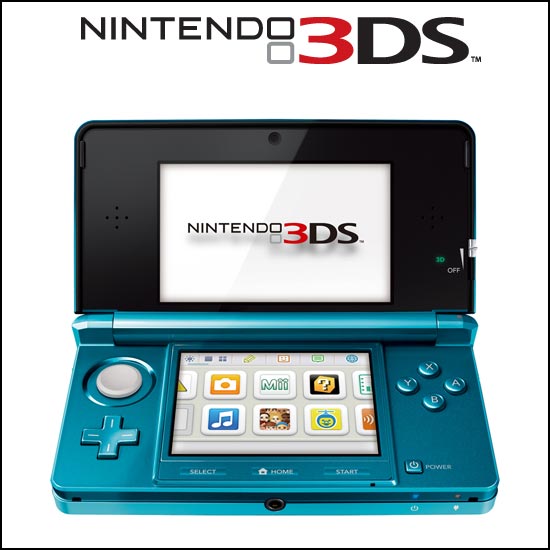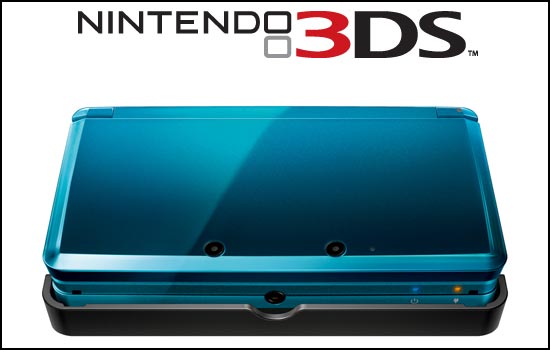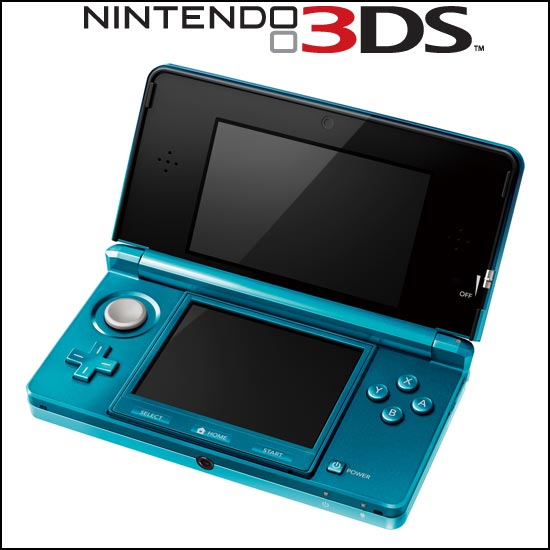With the North American launch of Nintendo’s 3DS handheld platform just a week away, we still know little to nothing about how the system will actually sound. In terms of technical specs, Nintendo only mentions that the system will have two speakers. I know this doesn’t sound adequate to readers here, but they’re probably making the correct assumption that most people gamers don’t care about the improvements made to the game’s audio capabilities. But they should!
We’ve been speaking with a number of developers over the past months regarding what they’ve been able to accomplish on the system, and from what we can tell, the possibilities on the 3DS are truly endless. Now we just have to hope that developers take notice and make use of the drastic improvements made over the Nintendo DSi that effectively put the 3DS on the same level as the Gamecube in terms of audio.
Just what improvements have been made, and how will they affect how you experience audio on the system? Hit the jump for our list.
1) Increased Cartridge Memory
Okay, I know this is obvious, but the higher data capacity on the 3DS cartridges will allow developers to allocate more space to music and sound effects. Just how much bigger, you ask? According to Kotaku [2], the 3DS cartridge is 2GB versus 512Mb on the Nintendo DS. Now, it really boils down to what developers will do with the additional space, but we’ll hopefully see an increased volume of music for handheld titles or, more excitingly, a shift to streaming soundtracks directly from the cartridge given that there’s more room to store larger, high-quality music files.
2) Playing with Processing Power
While processing power is often thought to be a determinant of graphical capabilities among gamers, it’s also incredibly important in determining what developers are able to do with the game’s audio. More processing power means an enhanced ability to have more things going on at once. The Nintendo 3DS supposedly sports two 266MHz ARM11 processors compared to the Nintendo DSi’s two 133MHz ARM9 processors according to Destructoid [3]. This will help the system trigger sound effects and stream music. This means less of an excuse to use MIDI, which has been the bane of several game soundtracks on Nintendo’s handheld platforms over the years.
This concept of streaming music is an important one that I don’t think a lot of us consider. To put it plainly, this increased processing power will make it easier to allocate the resources required to “stream” high-quality music files (like MP3, OGG, etc.) in real time, removing all limitations of what composers and sound designers can use to create their audio files, and will hopefully reduce the reliance on internal sound banks that have been used to reduce both processing resources and memory space.
3) RAM Upgrade
The correlation between this improvement and audio may not be the most obvious one to gamers, but let’s say that for some reason a developer decides to ignore the fact that they have increased data capacity and processing resources to stream high-quality audio and decide to go with MIDI anyway (we all know that companies will still do this). The increase in RAM (64MB versus the NDS’s 16MB according to Destructoid [3]) will allow larger sound banks to be loaded at once, meaning an ability to create more complex compositions with more instruments. Think of something along the lines of The Legend of Zelda: Twilight Princess, which, while relying mainly on MIDI sound banks, was pretty vast in terms of sounds used in the score.
4) Better Speakers
This is another obvious improvement, and is the only one that Nintendo mentions on their factsheet involving audio. Unfortunately, they’re still encased in a thick plastic with only tiny pinholes to allow the escape of sound! But worry not, for the next item makes the final output all the better.
5) Brand New Digital to Analog Converter (DAC)
Not only are the speakers worlds better than the ones featured on the DS and DSi, but more important, and less obvious, is an improved digital to analog converter (DAC). What’s a DAC? It essentially takes the digital data from the sound files on the cartridge and converts them into analog waves before they reach your ears. The Nintendo DS actually used the same converter all the way from the Game Boy Advance to the DS Lite, and there were serious problems with this component. It didn’t do a very good job, which is why so much of the sound coming out of the GBA and DS systems had that “crunchy” and “grainy” quality to it despite the best efforts of sound teams everywhere to provide high-definition tracks. This was improved with the DSi, and the 3DS features an even further upgrade. The fact that this component has been replaced with something better that functions like it’s supposed to will probably provide players with the biggest improvement in sound than any other improvement made to the 3DS. And you probably didn’t even know it existed!
__
Special thanks go out to our developer friends who have given us a heads-up as to what the 3DS will sound like. The system will be out next week, and we’re looking forward to seeing and hearing this entirely new experience.
What do you think of the above improvements? Is there anything else that the Nintendo 3DS has going for it in terms of audio that we didn’t mention?



Comments Disabled To "5 Reasons Why Audio on the Nintendo 3DS Should Be Amazing"
#1 Comment By Eyes On March 17, 2011 @ 3:41 pm
This was an article I was waiting for!
No one seems to be interested in sound, but don’t we all love great game soundtracks? (Zelda!) It is really important and this just makes me so happy!
#2 Comment By Stephen On March 18, 2011 @ 7:04 am
It may have potential for better sound, but what counts is if after taking the graphics computing into consideration there’s still room left for that. But hopefully they’ll have the room now to store instrument samples and streams at a CD-quality sampling rate, which didn’t always happen and is another contributor to the DS’s buzzy sound. Hopefully when streams are used they’ll have the ability to make them not really low bitrate like often is the case on the PSP.
I hope this is all we want it to be. Handhelds have had sub-par sound quality for far too long.
#3 Comment By Dave Gus On March 18, 2011 @ 1:00 pm
Very interesting. Thanks for raising our awareness.
#4 Comment By Gamer On March 19, 2011 @ 7:00 pm
I believe they upgraded the Digital to Analog convertor on the DSi to a 16 bit/48 KHZ one to handle ACC and the 3DS inherits this.However the GBA and DS/i series did Wavetable Synthesis on their main CPU’s which meaned tiny MIDI’s or low bit rate streaming with decent framerate or high bit rate streaming with low frame rate. The Gamecube and Wii use a a dedicated Macronix DSP core to handle Audio so Graphics does not take a hit. We just need to know if Audio is done on Main CPU or if the 3DS will inherit the Macronix DSP or similiar core from the Home Console.
#5 Comment By Jayson Napolitano On March 19, 2011 @ 7:19 pm
Ah, good question. We can look into that. I’m told that the entire setup is more along the lines of the GameCube as opposed to the GBA/DS/DSi, but I’m pretty sure that the DAC in the 3DS is entirely new (not inherited from the DSi).
#6 Comment By Gamer On March 20, 2011 @ 1:54 am
I have seen a demo video with direct feed audio of Kid Icarus on Youtube . That game seems to be doing high bit rate orchestral streams with a lot of sound effects and voice acting on top with no slow down in graphics or polygon counts. That gives the speculation there may be a dedicated DSP core doing the Audio.
#7 Comment By add On March 21, 2011 @ 5:28 pm
the thing has an mp3/ acc player built in, so i assume it will sound fairly high quality
#8 Comment By Jayson Napolitano On April 4, 2011 @ 2:38 pm
Hey, so I got the info. Apparently the DAC was changed in the DSi, but the one in the 3DS is even better than the one in the DSi. =)
#9 Comment By Gamer On October 13, 2011 @ 9:16 pm
There is indeed a dedicated Audio DSP in the 3DS. This two links proves it. [6] and [7] Qoute “Fixed a crash on the 3DS where if another system was pumping the DSP sound chip, you could deadlock. Now, in BinkSoundUse3DS, you call tell Bink to service the DSP or not.”
#10 Comment By Gamer On October 15, 2011 @ 12:28 pm
Here is two more links to show off some of the more advanced non-MIDI Audio of the 3DS.
[8]
and
[9]
I always figured there was dedicated programable audio hardware in the 3DS cause there is no way a slow underclocked “general purpose” 266mhz ARM11 could process high bit rate streamed tracks and mixed more sound effects plus voice acting on top as well have to process general game logic and graphics lists to be sent to the Pica200 GPU.
#11 Comment By Anonymous On November 24, 2013 @ 11:29 pm
I’m wondering if anyone ever figured out any more details of the actual DAC involved. It seems to me like the 3DS actually sounds pretty good. In fact, it seems to have a decent OPAMP because I can plug in my Sennheiser HD555s (which are low impedance and sensitive so easier to drive than most of the good quality headphones meaning it probably couldn’t handle much beyond them still, but at least it can handle them) and it sounds quite good.
Don’t forget though. Just because the potential quality of the physical output is good doesn’t mean the input will be. Few NDS games had good music anyway and so far of the 3DS games I’ve seen very few manage to excel in any way either. The Etrian Odyssey games do amazing music on the 3DS though. I think they just let the composer do what he wanted and didn’t impose any Loudness War restrictions on him or anything because there are even subtleties and dynamics in its music.
#12 Comment By Jayson Napolitano On November 25, 2013 @ 2:20 am
I think we agree that the DAC was same between GBA and DS, then with DSi they changed it, dramatic improvement. And that same new DAC carried over to 3DS. Not sure what the story has been from there.